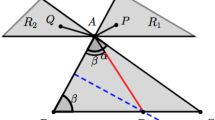Abstract
In this paper, we present an algorithm that utilizes a quadtree data structure to construct a quadrilateral mesh for a simple polygonal region in which no newly created angle is smaller than \({{18.43}}^{\circ} ({=}\hbox{arctan}(\frac{1}{3}))\) or greater than \({{171.86}}^{\circ} ({=}{{135}}^{\circ} + 2\hbox{arctan}(\frac{1}{3}))\). This is the first known result, to the best of our knowledge, on a direct quadrilateral mesh generation algorithm with a provable guarantee on the angles.





















































Similar content being viewed by others
References
Allman DJ (1988) A quadrilateral finite element including vertex rotations for plane elasticity analysis. Int J Numer Methods Eng 26:717–730
Atalay FB, Ramaswami S, Xu D (2008) Quadrilateral meshes with bounded minimum angle. In: Proceedings of the 17th International Meshing Roundtable. Springer, Heidelberg, pp 73–91
Benzley S, Perry E, Merkley K, Clark B, Sjaardema G (1995) A comparison of all hexahedral and all tetrahedral finite element meshes for elastic and elastic-plastic analysis. In: Proceedings of the 4th international meshing roundtable, pp 179–192
Bern M, Eppstein D (1997) Quadrilateral meshing by circle packing. In: 6th IMR, pp 7–19
Bern M, Eppstein D, Gilbert J (1994) Provably good mesh generation. J Comp Sys Sci 48:384–409
Blacker T, Stephenson M (1991) Paving: a new approach to automated quadrilateral mesh generation. Int J Numer Methods Eng 32(4):811–847
Brauer, JR (eds) (1993) What every engineer should know about finite element analysis, 2nd edition. Marcel-Dekker, NY
Cheng S-W, Dey T, Ramos E, Ray T (2004) Quality meshing for polyhedra with small angles. In: Proceedings 20th annual symposium on computational geometry
Chew LP (1993) Guaranteed-quality mesh generation for curved surfaces. In: Proceedings of the 9th ACM symposium on computational geometry, pp 274–280
Chew LP (1997) Guaranteed-quality delaunay meshing in 3d. In: Proceedings of the 13th ACM symposium on computational geometry, pp 391–393
Edelsbrunner H (1987) Algorithms in combinatorial geometry. Springer, Berlin
Everett H, Lenhart W, Overmars M, Shermer T, Urrutia J (1992) Strictly convex quadrilaterilizations of polygons. In: Proceedings 4th Canadian conference on computational geometry, pp 77–82
Hine S, Atalay FB, Xu D, Ramaswami S (2009) Video: quadrilateral meshes with bounded minimum angle. In: Proceedings 25th ACM symposium on computational geometry (SoCG 2009), pp 90–91
Robinson J (1987) Cre method of element testing and the jacobian shape parameters. Eng Comput 4:113–118
Johnston BP, Sullivan JM, Kwasnik A (1991) Automatic conversion of triangular finite meshes to quadrilateral elements. Int J Numer Methods Eng 31(1):67–84
Knupp Patrick M (2000) Achieving finite element mesh quality via optimization of the jacobian matrix norm and associated quantities. Part i—a framework for surface mesh optimization. Int J Numer Methods Eng 48:401–420
Miller GL, Talmor D, Teng S-H, Walkington N (1995) A delaunay based numerical method for three dimensions: Generation, formulation, and partition. In: Proceedings of the 27th ACM symposium on the theory of computing, pp 683–692
Mitchell S, Vavasis S (1992) Quality mesh generation in three dimensions. In: Proceedings of the 8th annual symposium on computational geometry, pp 212–221
Ramaswami S, Siqueira M, Sundaram T, Gallier J, Gee J (2005) Constrained quadrilateral meshes of bounded size. Int J Comput Geom Appl 15(1):55–98 (invited to special issue of selected papers from the 12th IMR)
Shewchuk J (2002) Constrained Delaunay tetrahedralizations and provably good boundary recovery. In: Proceedings of the 11th international meshing roundtable, pp 193–204
Shewchuk JR (1996) Triangle: engineering a 2D quality mesh generator and Delaunay triangulator. In: Applied computational geometry: towards geometric engineering. LNCS, vol 1148
Zienkiewicz OC, Taylor RL (1989) The finite element method. McGraw-Hill, NY
Acknowledgments
The authors would like to thank anonymous reviewers for helpful comments that served to significantly improve the presentation in the paper.
Author information
Authors and Affiliations
Corresponding author
Rights and permissions
About this article
Cite this article
Atalay, F.B., Ramaswami, S. & Xu, D. Quadrilateral meshes with provable angle bounds. Engineering with Computers 28, 31–56 (2012). https://doi.org/10.1007/s00366-011-0215-0
Received:
Accepted:
Published:
Issue Date:
DOI: https://doi.org/10.1007/s00366-011-0215-0




